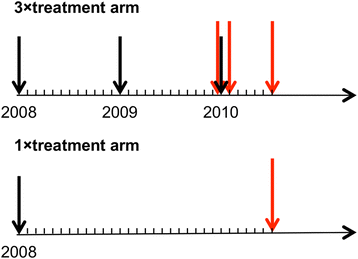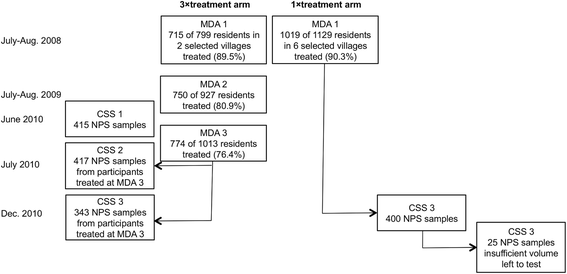Short-term increase in prevalence of nasopharyngeal carriage of macrolide-resistant Staphylococcus aureus following mass drug administration with azithromycin for trachoma control
- PMID: 28351345
- PMCID: PMC5371190
- DOI: 10.1186/s12866-017-0982-x
Short-term increase in prevalence of nasopharyngeal carriage of macrolide-resistant Staphylococcus aureus following mass drug administration with azithromycin for trachoma control
Abstract
Background: Mass drug administration (MDA) with azithromycin is a corner-stone of trachoma control however it may drive the emergence of antimicrobial resistance. In a cluster-randomized trial (Clinical trial gov NCT00792922), we compared the reduction in the prevalence of active trachoma in communities that received three annual rounds of MDA to that in communities that received a single treatment round. We used the framework of this trial to carry out an opportunistic study to investigate if the increased rounds of treatment resulted in increased prevalence of nasopharyngeal carriage of macrolide-resistant Staphylococcus aureus. Three cross-sectional surveys were conducted in two villages receiving three annual rounds of MDA (3 × treatment arm). Surveys were conducted immediately before the third round of MDA (CSS-1) and at one (CSS-2) and six (CSS-3) months after MDA. The final survey also included six villages that had received only one round of MDA 30 months previously (1 × treatment arm).
Results: In the 3 × treatment arm, a short-term increase in prevalence of S. aureus carriage was seen following MDA from 24.6% at CSS-1 to 38.6% at CSS-2 (p < 0.001). Prevalence fell to 8.8% at CSS-3 (p < 0.001). A transient increase was also seen in prevalence of carriage of azithromycin resistant (AzmR) strains from 8.9% at CSS-1 to 34.1% (p < 0.001) in CSS-2 and down to 7.3% (p = 0.417) in CSS-3. A similar trend was observed for prevalence of carriage of macrolide-inducible-clindamycin resistant (iMLSB) strains. In CSS-3, prevalence of carriage of resistant strains was higher in the 3 × treatment arm than in the 1 × treatment (AzmR 7.3% vs. 1.6%, p = 0.010; iMLSB 5.8% vs. 0.8%, p < 0.001). Macrolide resistance was attributed to the presence of msr and erm genes.
Conclusions: Three annual rounds of MDA with azithromycin were associated with a short-term increase in both the prevalence of nasopharyngeal carriage of S. aureus and prevalence of carriage of AzmR and iMLSB S. aureus.
Trial registration: This study was ancillary to the Partnership for the Rapid Elimination of Trachoma, ClinicalTrials.gov NCT00792922 , registration date November 17, 2008.
Keywords: Azithromycin; Macrolide resistance; Mass drug administration; Staphylococcus aureus carriage; The Gambia; Trachoma; West Africa; iMLSB.
Figures
Similar articles
-
Antibiotics for trachoma.Cochrane Database Syst Rev. 2019 Sep 26;9(9):CD001860. doi: 10.1002/14651858.CD001860.pub4. Cochrane Database Syst Rev. 2019. PMID: 31554017 Free PMC article.
-
Mass administration of azithromycin and Streptococcus pneumoniae carriage: cross-sectional surveys in the Gambia.Bull World Health Organ. 2014 Jul 1;92(7):490-8. doi: 10.2471/BLT.13.133462. Epub 2014 Apr 29. Bull World Health Organ. 2014. PMID: 25110374 Free PMC article. Clinical Trial.
-
Mass distribution of azithromycin for trachoma control is associated with increased risk of azithromycin-resistant Streptococcus pneumoniae carriage in young children 6 months after treatment.Clin Infect Dis. 2013 Jun;56(11):1519-26. doi: 10.1093/cid/cit137. Epub 2013 Mar 13. Clin Infect Dis. 2013. PMID: 23487375
-
Mass drug administration with azithromycin for trachoma elimination and the population structure of Streptococcus pneumoniae in the nasopharynx.Clin Microbiol Infect. 2021 Jun;27(6):864-870. doi: 10.1016/j.cmi.2020.07.039. Epub 2020 Aug 1. Clin Microbiol Infect. 2021. PMID: 32750538 Free PMC article.
-
Antimicrobial resistance following mass azithromycin distribution for trachoma: a systematic review.Lancet Infect Dis. 2019 Jan;19(1):e14-e25. doi: 10.1016/S1473-3099(18)30444-4. Epub 2018 Oct 3. Lancet Infect Dis. 2019. PMID: 30292480
Cited by
-
Long-term Impact of Oral Azithromycin Taken by Gambian Women During Labor on Prevalence and Antibiotic Susceptibility of Streptococcus pneumoniae and Staphylococcus aureus in Their Infants: Follow-up of a Randomized Clinical Trial.Clin Infect Dis. 2018 Sep 28;67(8):1191-1197. doi: 10.1093/cid/ciy254. Clin Infect Dis. 2018. PMID: 29608659 Free PMC article. Clinical Trial.
-
The impact of long-term azithromycin on antibiotic resistance in HIV-associated chronic lung disease.ERJ Open Res. 2021 Feb 7;8(1):00491-2021. doi: 10.1183/23120541.00491-2021. eCollection 2022 Jan. ERJ Open Res. 2021. PMID: 35141318 Free PMC article.
-
Antibiotics for trachoma.Cochrane Database Syst Rev. 2019 Sep 26;9(9):CD001860. doi: 10.1002/14651858.CD001860.pub4. Cochrane Database Syst Rev. 2019. PMID: 31554017 Free PMC article.
-
Genomics of Ocular Chlamydia trachomatis After 5 Years of SAFE Interventions for Trachoma in Amhara, Ethiopia.J Infect Dis. 2022 Mar 15;225(6):994-1004. doi: 10.1093/infdis/jiaa615. J Infect Dis. 2022. PMID: 33034349 Free PMC article.
-
Longer-Term Assessment of Azithromycin for Reducing Childhood Mortality in Africa.N Engl J Med. 2019 Jun 6;380(23):2207-2214. doi: 10.1056/NEJMoa1817213. N Engl J Med. 2019. PMID: 31167050 Free PMC article.
References
-
- World Health Organization . Report of the first meeting of the WHO alliance for the Global Elimination of Trachoma, WHO/PBL/GET/97.1. 1997.
-
- World Health Organization . Report of the third meeting of the WHO Alliance for the Global Elimination of Trachoma, WHO/PBD/GET/99.3. 1998.
-
- Matheson AI, Manhart LE, Pavlincan PB, Means AR, Akullian A, Levine GA, et al. Prioritizing countries for interventions to reduce child mortality: tools for maximizing the impact of mass drug administration of azithromycin. PLoS One. 2014;9:e96658. doi: 10.1371/journal.pone.0096658. - DOI - PMC - PubMed
Publication types
MeSH terms
Substances
Associated data
Grants and funding
LinkOut - more resources
Full Text Sources
Other Literature Sources
Medical



